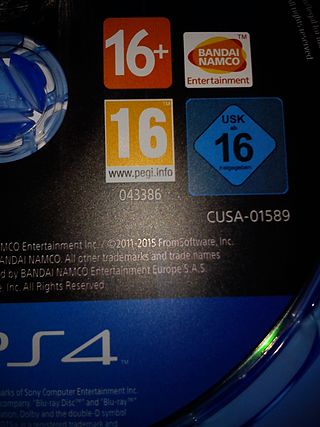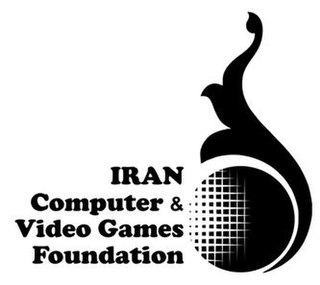
A video game or computer game is an electronic game that involves interaction with a user interface or input device to generate visual feedback from a display device, most commonly shown in a video format on a television set, computer monitor, flat-panel display or touchscreen on handheld devices, or a virtual reality headset. Most modern video games are audiovisual, with audio complement delivered through speakers or headphones, and sometimes also with other types of sensory feedback. Some video games also allow microphone and webcam inputs for in-game chatting and livestreaming.

The Entertainment Software Rating Board (ESRB) is a self-regulatory organization that assigns age and content ratings to consumer video games in North America. The ESRB was established in 1994 by the Entertainment Software Association, in response to criticism of controversial video games with excessively violent or sexual content, particularly after the 1993 congressional hearings following the releases of Mortal Kombat and Night Trap for home consoles and Doom for home computers. The industry, pressured with potential government oversight of video game ratings from these hearings, established both the IDSA and the ESRB within it to create a voluntary rating system based on the Motion Picture Association of America film rating system with additional considerations for video game interactivity.
Video game modding is the process of alteration by players or fans of one or more aspects of a video game, such as how it looks or behaves, and is a sub-discipline of general modding. Mods may range from small changes and tweaks to complete overhauls, and can extend the replay value and interest of the game.
In video games, censorship are efforts by an authority to limit access, censor content, or regulate video games or specific video games due to the nature of their content. Some countries will do this to protect younger audiences from inappropriate content using rating systems such as the ESRB rating system. Others will do this to censor any negative outlook on a nation's government.

Sony Interactive Entertainment LLC (SIE) is an American multinational video game and digital entertainment company of Sony. Jointly established by two subsidiaries in 2016, it primarily operates the PlayStation brand of video game consoles and products. It is also the world's largest company in the video game industry based on its equity investments.

GamePro was an American multiplatform video game magazine media company that published online and print content covering the video game industry, video game hardware and video game software. The magazine featured content on various video game consoles, personal computers and mobile devices. GamePro Media properties included GamePro magazine and their website. The company was also a part subsidiary of the privately held International Data Group (IDG), a media, events and research technology group. The magazine and its parent publication printing the magazine went defunct in 2011, but is outlasted by Gamepro.com.
1994 saw many sequels and prequels in video games, such as Super Metroid, Donkey Kong Country, Final Fantasy VI, Sonic 3 & Knuckles, Super Street Fighter II Turbo and Virtua Fighter 2 and Doom II, along with new titles such as Daytona USA, Ace Driver, Alpine Racer and Tekken.
Video games featuring sexual content has been found since the early days of the industry and can be found on most platforms and can be of any video game genre.

The relationship between women and video games has received extensive academic and media attention. Since the 1990s, female gamers have commonly been regarded as a minority. However, industry surveys have shown that over time, the gender ratio has become closer to equal. Beginning mainly in the 2010s, women have been found to make up around half of all gamers. The gender ratio differs significantly between game genres, and women are highly underrepresented in genres such as first-person shooters and grand strategy games. Sexism in video gaming, including sexual harassment, as well as underrepresentation of women as characters in games, is an increasing topic of discussion in video game culture.
A content rating rates the suitability of TV shows, movies, comic books, or video games to this primary targeted audience. A content rating usually places a media source into one of a number of different categories, to show which age group is suitable to view media and entertainment. The individual categories include the stated age groups within the category, along with all ages greater than the ages of that category.

A video game content rating system is a system used for the classification of video games based on suitability for target audiences. Most of these systems are associated with and/or sponsored by a government, and are sometimes part of the local motion picture rating system. The utility of such ratings has been called into question by studies that publish findings such as 90% of teenagers claim that their parents "never" check the ratings before allowing them to rent or buy video games, and as such, calls have been made to "fix" the existing rating systems. Video game content rating systems can be used as the basis for laws that cover the sales of video games to minors, such as in Australia. Rating checking and approval is part of the game localization when they are being prepared for their distribution in other countries or locales. These rating systems have also been used to voluntarily restrict sales of certain video games by stores, such as the German retailer Galeria Kaufhof's removal of all video games rated 18+ by the USK following the Winnenden school shooting.
The Game Rating and Administration Committee, formerly the Game Rating Board until December 23, 2013, is the South Korean video game content rating board. A governmental organization, the GRAC rates video games to inform customers of the nature of game contents.
In communication, media are the outlets or tools used to store and deliver content; semantic information or subject matter of which the media contains. The term generally refers to components of the mass media communications industry, such as print media, publishing, news media, photography, cinema, broadcasting, digital media, and advertising.
The United Kingdom has the largest video game sector in Europe. By revenue, the UK had the second-largest video game market in Europe in 2022 after Germany, and the sixth-largest globally. By sales, it is Europe's largest market, having overtaken Germany in 2022. The UK video game market was worth £7.16 billion in 2021, a 2% increase over the previous year.

Video gaming in the United States is one of the fastest-growing entertainment industries in the country. The American video game industry is the largest video game industry in the world. According to a 2020 study released by the Entertainment Software Association, the yearly economic output of the American video game industry in 2019 was $90.3 billion, supporting over 429,000 American jobs. With an average yearly salary of about $121,000, the latter figure includes over 143,000 individuals who are directly employed by the video game business. Additionally, activities connected to the video game business generate $12.6 billion in federal, state, and local taxes each year. World Economic Forum estimates that by 2025 the American gaming industry will reach $42.3 billion while worldwide gaming industry will possibly reach US$270 billion. The United States is one of the nations with the largest influence in the video game industry, with video games representing a significant part of its economy.

Oculus Rift is a discontinued line of virtual reality headsets developed and manufactured by Oculus VR, a virtual reality company founded by Palmer Luckey that is widely credited with reviving the virtual reality industry. It was the first virtual reality headset to provide a realistic experience at an accessible price, utilizing novel technology to increase quality and reduce cost by orders of magnitude compared to earlier systems. The first headset in the line was the Oculus Rift DK1, released on March 28, 2013. The last was the Oculus Rift S, discontinued in April 2021.

The Iran Computer and Video Games Foundation (ICVGF), also known as the National Foundation for Computer Games (NFCG), is an Iranian nonprofit organization established by the Ministry of Culture and Islamic Guidance to control and support the video game industry in Iran.

On December 9, 1993, and March 4, 1994, members of the combined United States Senate Committees on Governmental Affairs and the Judiciary held congressional hearings with several spokespersons for companies in the video game industry including Nintendo and Sega, involving violence in video games and the perceived impacts on children. The hearing was a result of concerns raised by members of the public on the 1993 releases of Night Trap, Mortal Kombat and later Doom which was released after the first hearing. Besides general concerns related to violence in video games, the situation had been inflamed by a moral panic over gun violence, as well as the state of the industry and an intense rivalry between Sega and Nintendo.





















